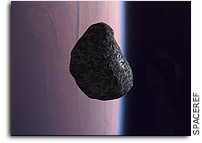Lithopanspermia in Star Forming Clusters

http://images.spaceref.com/news/2002/06.06.02.rock.earth.jpg
Astrophysics, abstract
astro-ph/0504648
From: Fred C. Adams [view email]
Date: Fri, 29 Apr 2005 13:07:16 GMT (32kb)
Lithopanspermia in Star Forming Clusters
Authors:
Fred C. Adams,
David N. Spergel
Comments: 27 pages including 5 figures; accepted to Astrobiology
This paper considers the lithopanspermia hypothesis in star forming groups
and clusters, where the chances of biological material spreading from one solar
system to another is greatly enhanced (relative to the field) due to the close
proximity of the systems and lower relative velocities. These effects more than
compensate for the reduced time spent in such crowded environments. This paper
uses 300,000 Monte Carlo scattering calculations to determine the cross
sections for rocks to be captured by binaries and provides fitting formulae for
other applications. We assess the odds of transfer as a function of the
ejection speed and number of members in the birth aggregate. The odds of any
given ejected meteroid being recaptured by another solar system are relatively
low. Because the number of ejected rocks per system can be large, virtually all
solar systems are likely to share rocky ejecta with all of the other solar
systems in their birth cluster. The number of ejected rocks that carry living
microorganisms is much smaller and less certain, but we estimate that several
million rocks can be ejected from a biologically active solar system. For
typical birth environments, the capture of life bearing rocks is expected to
occur 10 — 16,000 times per cluster (under favorable conditions), depending on
the ejection speeds. Only a small fraction of the captured rocks impact the
surfaces of terrestrial planets, so that only a few lithopanspermia events are
expected (per cluster).
Full-text: PostScript, PDF, or Other formats
References and citations for this submission:
SLAC-SPIRES HEP (refers to ,
cited by, arXiv reformatted)
Which authors of this paper are endorsers?








